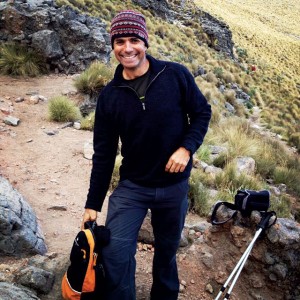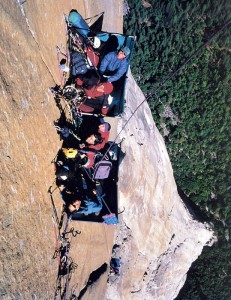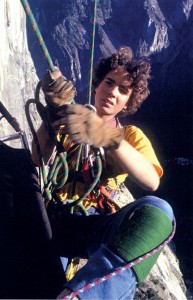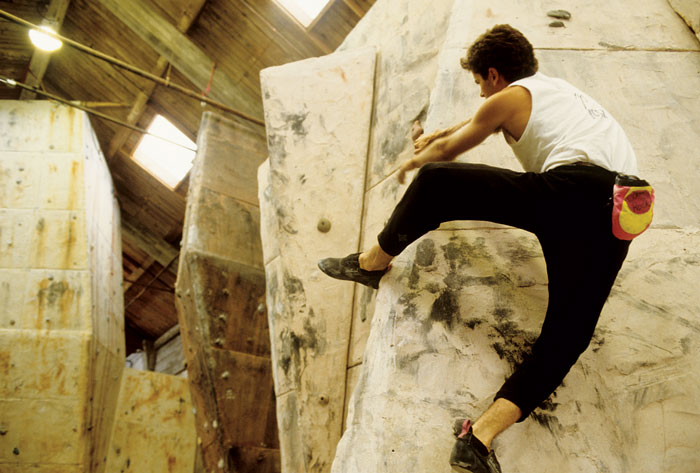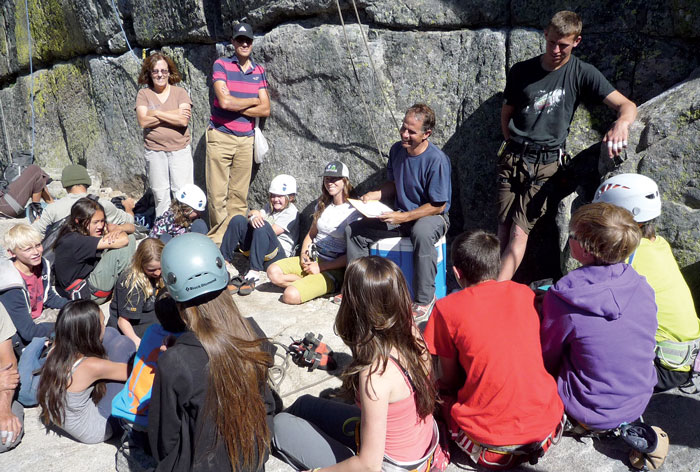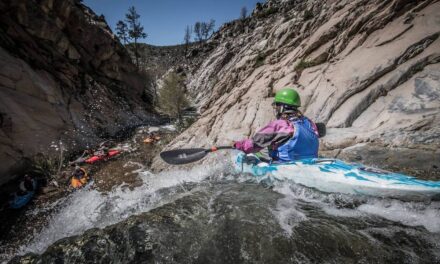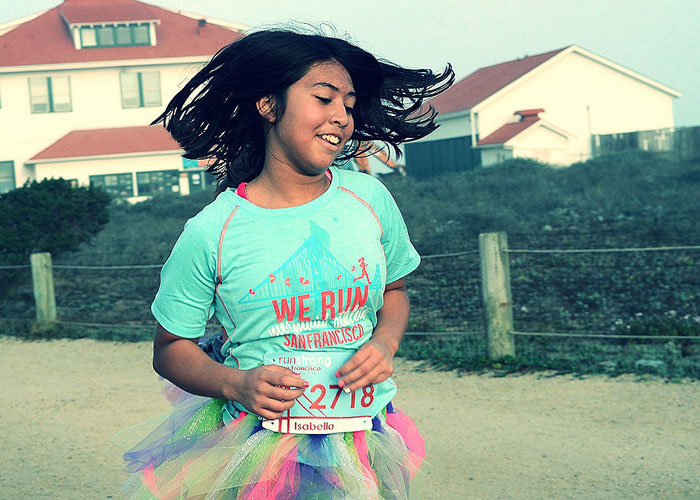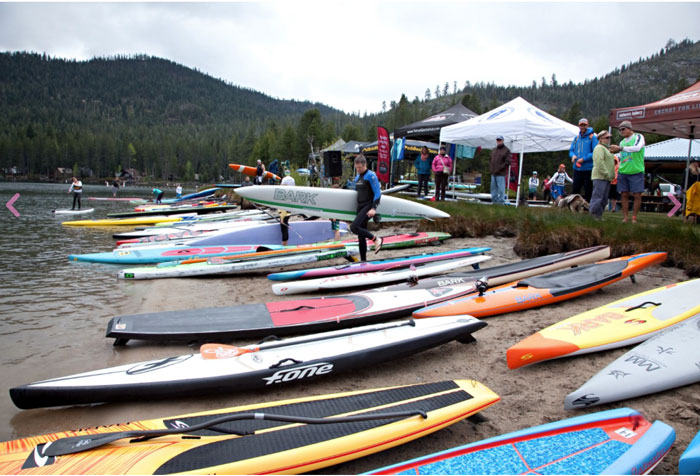- Tahoe’s Nevada Beach Tops the List of Hard-to-Book Campgrounds - 07/17/2024
- Cannabis Watershed Protection Program Cleans Up Illegal Grow Sites - 07/10/2024
- French Fire - 07/05/2024
From climbing prodigy to rock gym pioneer to outdoor educator, Peter Mayfield is just hitting his stride
By Brad Rassler
In the predawn hours of July 13, 2011, Peter Mayfield walked through the skeletal remains of Manzanar, the mothballed World War II Japanese internment camp located hard by Highway 395, in California’s Eastern Sierra. Seven miles distant, in serpentine repose, lay Mayfield’s objective for that day: the Himalayan-scaled northeast ridge of Mt. Williamson, with its 10,000 vertical feet of weathered granite stretching from high desert scrub to its 14,389’ summit — the longest ridge in the Sierra Nevada.
Glancing downrange, Mayfield could just make out the monolithic east arête of 13,225’ Mt. Carl Heller, bathed in alpenglow; beyond Carl Heller, and out of view, loomed the summits of Mts. Russell and Whitney, both over 14,000 feet, with Whitney, of course, the highest of them all. With just a three day break amidst an otherwise unrelenting summer schedule at his environmental school, the Gateway Mountain Center, Mayfield intended to enchain those peaks, descend to the valley, and drive home before his next group arrived at Gateway’s base camp on Donner Summit.
But here he was, captured by the grounds of California’s most infamous relocation camp, where 10,000 Japanese Americans languished during
the height of the war. And though he had many miles to cover, Mayfield just couldn’t pull himself away from the place. He had skirted Manzanar’s denuded cell blocks and now approached the ragged cemetery, with its few barren gravesites outlined with cobbles, the susurrus of origami ribbons swirling from a lone Kanji-inscribed obelisk. He fought back a shiver; Manzanar felt strangely alive, haunted. He paused and breathed in the sad spirit of that place. Breathing out, his mind now calm, he nodded to the obelisk, and slowly made his way to the barbed wire fence ringing the compound; he ducked under it, and figuratively bowed to the memories of those who had suffered through sweltering summers and frigid winters there.
As he struck out across the alluvium of Bairs Creek toward Williamson’s ramparts, having made an uneasy peace with Manzanar’s haunting grip, the pathos of the situation wasn’t lost on him: he had been free to liberate himself from that wind-whipped place, where those once interned there could only dream of doing the same.
Three mornings later, after a marathon effort, Mayfield soloed the technical East Face of Mt. Whitney. He sat alone on the summit, squinting eastward as the sun rose over the Inyos, and then he shifted his gaze to the north to behold the 30 miles of ridgeline he had just traversed, most of it over 13,000 feet. He had gotten what he had come for: Not glory — he had told only close friends about his plans. Not the summits — although he had joyously touched them all, flowing up those technical east aspects without difficulty. He had come to the hallowed ground of the Sierra Nevada alone, soaking in the solitude, and sleeping in the open, cradled by talus and krummholz. Setting out from Manzanar had only deepened the journey’s poignancy.
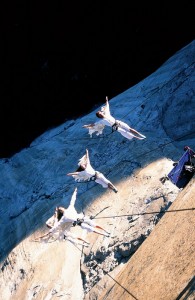
Peregrine Dreams performance on the Shield, 1997. Dancers: Chris Clay, Heather Baer, Amelia Rudolph, Peter Mayfield. Photo: Steve Schneider
And that’s Mayfield’s way: His relationship with California’s mountains has been redemptive, if not symbiotic. He has ventured deep into the Sierra, and has found a wellspring of inspiration in the range’s wildness. And like other of the Sierra’s inveterate wanderers — John Muir comes to mind — he has given back more to the mountains than he has ever taken from them.
“My life was changed by developing a relationship with the Sierra,” Mayfield now says, “and my whole life has been dedicated to connecting other people to that same experience.”
“He has an ability to be humble and kind and generous with his incredible set of skills,” says Amelia Rudolph, with whom Mayfield founded the internationally renowned dance troupe Project Bandaloop. “He’s capable of doing things in the mountains few humans can,” she says, “and he’s of that elite group of climbers who has nothing to prove, so really it’s more about the generosity of spirit, and his wanting to give his gifts away.”
Peter Curry Mayfield was born in 1962 in San Francisco’s Presidio Hospital to an 18-year old Cal student whose unsettled life precluded her ability to raise a child; she made the difficult decision to put him up for adoption. He touched down in Sacramento, with a psychiatrist – his father, and a social worker – his mother, and three younger siblings, also adopted. He describes himself as an independent, precocious and outgoing child who was small for his age. He naturally gravitated to outdoor activities, especially skiing, to which he was introduced when he was six. He was good enough to be allowed to join Sacramento’s Alpine Junior Skiers a few years earlier than the allowable minimum age. “My parents were always negotiating my way into things I wasn’t old enough for,” he says.
He climbed for the first time at summer camp at nine. The following year on a YMCA trip to Yosemite he followed one of his counselors up the right side of Monday Morning Slab. His parents divorced, and several years later Mayfield moved to Berkeley to live with his father, whose house was on Grizzly Peak. Mayfield recalls discovering Remillard Park and finding members of the Sierra Club’s Rock Climbing Section (RCS) dangling from strands of Goldline sprouting from Pinnacle Rock. He attached himself to them as a mentee. He became, in his own words, obnoxiously passionate about the sport.
“In seventh grade, I was fully a climber, with a swami belt, and EB shoes, and was bouldering at Indian Rock, and was leading. I led 5.6s, 5.7s, and then 5.8s — a fairly normal progression at the time.” He had total recall of Roper’s Yosemite guidebook years before he became a Valley denizen. He peregrinated between RCS climbing outings and the finger-blistering bouldering scene at Indian Rock — climbers tended to belong to either one tribe or the other in those days — which is about the time he led the crux pitches of the Lost Arrow Tip on an RCS outing. He spent the summer of his 15th year in Tuolumne, and by season’s end had led Piece de Resistance, an unusually precocious climb for a youngster of that era, although other young teens served as inspiration; Bill Price had led Butterballs when he was 15, and Kauk had put up Tales of Power at 16, and Mayfield repeated those ascents at the same ages. At 17 he made a very early free ascent of the Gunks testpiece, Supercrack.
He recalls only a handful of people climbing 5.12 in 1978. He was one of them.
He became known as a nice kid and stylish climber keen to teach. In fact, he was a born instructor. Starting at 12 he worked as a teacher’s aid at the Starr King Exceptional School, a school for disabled children. He became the youngest Sierra Club Outings leader at age 15. “Even then when I was trying to be a hotshot climber, I was still very identified as a Sierra Club instructor,” Mayfield says.
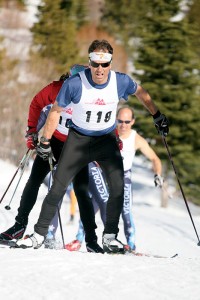
Peter Mayfield leads a strong group of racers at the 2011 Skoggsloppet at Tahoe Donner Cross Country.
Photo: Mark Nadell, www.macbethgraphics.com
And, of course, he made the heart of the Sierra his home.
“I went to Yosemite full time at 17 thinking I was going to spend a few years climbing hard before going back to school where I had thrived,” Mayfield wrote on Supertopo’s Forum. “Met a cute waitress with an infant, and was soon a step-dad, homeowner in El Portal, and then a father at the age of 20. Quickly becoming a bit of a leader in the small pond of guiding and ski instruction, paradoxically, I spent my 20’s more grounded and ‘responsible’ than I have lived any time since.”
At 18 he was guiding for Yosemite Mountaineering School, and at 20, he became the school’s Chief Guide, a post he held for four years. Winters he taught cross-country skiing, and became Chief Examiner for the Western Division of the Professional Ski Instructors of America. When his climbing cohorts were dirtbagging it in the Valley, Mayfield lived in El Portal, and fathered a son, Braden, now 30.
Meanwhile, he was putting up some of the neckiest wall routes in the Valley, teaming with his big wall mentor Jim Bridwell, with whom he would climb Zenyatta Mondatta and The Big Chill on Half Dome. Bridwell remembers Mayfield as a bold and skillful leader who mastered the big wall game quickly. He recalls one of Mayfield’s leads on The Big Chill with just four Beaks between him and the belay.
“He’s stronger than he looks,” says Bridwell, “and a lot of that is character.”
In 1981 Mayfield traveled to Peru — the “Rock Punks in the Andes” expedition — to try his hand at expeditionary climbing. He made first ascents on Ranrapalca and San Juan with friends Dave Diegelman and Auggie Klein, and a solo ascent of Huascaran’s Shield Route.
Back home he on-site free soloed the 574-foot Silver Strand, one of the Valley’s ephemeral ice epics. It wasn’t a premeditated climb; he walked up to the base to see how it would go. A hundred feet later, he was committed. It was tenuous and messy, and rotten, but yes, it went. He now calls it one of the most intense days of his life. The climb proved pivotal in that it marked a turning away from extreme risk-taking. He could have had a great career as expeditionary climber, but with a two-year old at home, he didn’t want to end up a dead dad.
Mayfield only recounts these climbs and others at the urging of the interviewer. He does so quietly, meditatively. He’d object to a writer using verbs like “bag,” “shred,” “flash,” “send,” “crank,” or any other phrase smacking of man’s domination over natural ground. He’s proud of his athletic accomplishments, but they do not define him; he seems to have funneled these experiences into a career of serving others less fortunate or gifted or much younger than he.
That isn’t to say he’s without a healthy ego – he’s not above setting the record straight about his exploits on Supertopo – and he admits to an outsize vision that steals from his ability to focus on the fine details and economic instrumentalism which are unfortunate preconditions to first world living. He’s still grappling with the mental detritus his early years as an adopted child might have stirred up, although he reunited with his birth mother thirty years ago, and the two are family.
His mind’s eye is awash in ideas – always ideas. Mayfield and the author were skiing at Royal Gorge a few years ago on that big hill in front of Summit Station, working on V1, when Mayfield stopped like a smitten Saul.
“Everything O.K., Peter?”
“Look at this hill,” he said, gesturing across the slope.
“Whaddaboutit?”
“This place could be an awesome musical venue.” He points to the base of the hill. “There’s the stage.” He points underfoot. “People sit here. What a great thing it would be for this place! If I had the time, I’d organize it.”
That’s Peter: so many possibilities, so little time.
Whatever. He’s a visionary, yes, but he’s mainly a soulful type who’s mostly about doing well by doing good.
Take his climbing gym, for example.
He was encamped with Bridwell on the Ruth Glacier during an attempt on the east face of Moose’s Tooth when Bridwell told Mayfield about climbing sculptures he had seen when climbing in Arco, Italy. Mayfield, then 26, conceived of a special kind of climbing facility he could bring to the masses — the first of its kind — an urban climbing gymnasium in the classical sense of the word. Mayfield envisioned sculpted faux rock walls shaped to an industrial space with a 45-foot clear height. He’d bring in yoga instructors, aerial dancers, offer equipment rentals, sell food and gear. Within five months of shopping the idea, he had raised a half-million dollars, and launched into plans to locate the facility in Emeryville. He called it CityRock.
“I was trying to bring the transformational experience, the mind-body connecting experience of rock climbing to thousands of people who wouldn’t otherwise do it, by building a sculpture in the middle of the city to do it on,” he says.
“I was pretty impressed with what he created with that gym,” says Bridwell, who is normally sparing with his praise. “I thought, yeah, this is the future of suburban climbing.”
And so it was. Mayfield’s CityRock became the Ur-climbing gym, and his vision can be glimpsed in the hundreds of similarly modeled facilities across the country.
It was at CityRock where Mayfield and Rudolph met and envisioned taking modern dance to vertical ground; Rudolph learned to climb, and Mayfield learned to dance. He’s proud of the years he spent perfecting his pirouettes. Footwork, finesse, and technique: embodied movement has figured prominently in Mayfield’s endeavors both on and off rock and snow, whether leading A5, climbing 5.13, or embarking on trans-Sierra skate skiing expeditions unprecedented in the history of the Range of Light: Southern Yosemite High Route, Badger to Mammoth, 55 miles in 38 hours.
At CityRock Mayfield and his partners had created a world-class venue that had brought indoor climbing to the Bay Area in a big way, but Mayfield’s focus was increasingly on using the gym as an outreach vehicle. His partners were more intent on sticking to the business plan. Mayfield bade CityRock adieu, and followed his muse back to the El Portal and the Valley, where he created Yosemite Guides, a coupling of environmental education and wilderness interpretation with “soft” adventure outings in and around the Park — a novel concept at the time, which would later be called “ecotourism.” Again, Mayfield’s intention wasn’t so much to provide a shrink-wrapped experience as much as he wished to deepen the public’s appreciation for the natural world.
“Even that entrepreneurial endeavor was mainly about teaching. So I guess in a way it’s the story of an athlete giving back. That sounds weird — kind of trite — but I suppose it’s true,” he says.
Mayfield turned 50 last year. He’s a handsome, urbane man who bears a slight resemblance to Neil Diamond throughout that pop star’s various incarnations. Well-earned crows feet frame his youthful eyes, and his hair is going gray. He’s of middling stature, and is absent of the pinched visage of endurance athletes of his caliber. He looks so normal in fact, you might delude yourself into believing you can hang with him in the mountains.
That would be a mistake. He can outrun, out-ski, and out-climb you. But unless you’re racing against him, he’s more likely to hang by your side.
These days Mayfield is pouring his prodigious energies into Gateway Mountain Center, and he may just be revolutionizing environmental education by intermixing the disciplines of field science, natural and human history, anthropology, systems thinking with both place-based education and wellness programming, which all told, leads to a kind of transformative learning.
“We’re opening young people’s hearts and minds to the natural world,” he says. “Our mission is to engage, impel and empower them to become knowledgeable, passionate, conscientious stewards of themselves, their communities, the environment, and our world.”
In his Last Child in the Woods, journalist Richard Louv gave a name to a kind of mass shying away from felt experiences in natural settings: nature-deficit disorder.
“Our society is teaching young people to avoid direct experience in nature,” he wrote. “Our institutions, urban/suburban design, and cultural attitudes unconsciously associate nature with doom. Well-meaning public school systems, media and parents are effectively scaring children straight out of the woods and fields.”
Louv posited that our alienation from nature comes at a tremendous cost to the human animal, including “diminished use of the senses, attention difficulties, and higher rates of physical and emotional illnesses. The disorder can be detected in individuals, families, and communities.”
Al Adams, the recently retired Headmaster of San Francisco’s Lick-Wilmerding High School — coincidentally, Mayfield’s alma mater — and a past client of Gateway, believes Mayfield’s interdisciplinary and experiential approach to environmental education may well prove the cure to what ails kids today.
“Gateway Mountain Center enables kids to have a wilderness experience in a safe way,” says Adams. “Just a baseline of connection to the environment and the outdoors is huge.”
Adams, who trained at Harvard, was impressed with Gateway’s talented staff, but most impressed with Mayfield himself.
“The first thing that comes across when you meet him is that sparkle in his eyes that conveys the passion and clarity of his vision,” he says. “He’s a great people person with a high degree of emotional intelligence, and that’s just huge for any leader of an educational institution — he possesses left brain reasoning, but it’s his right-brain affective relational sensibility that makes him really stand out.”
Terry and Alex Meadows of Kentfield, California, sent their son, Austin (not their real names), to Gateway’s summer camp three years ago. Austin is small for his age, and suffers from Tourette Syndrome, ADHD, and a tic disorder, all of which has made him an easy target for bullying at school. Terry wanted Austin to try climbing, but the minimum age was 14.
“Peter identified with Austin, and let him climb with the older kids, and sure enough, Austin thrived,” Terry says. “Austin said he felt good every time he was around Peter – he just adored him.”
“He showed me that I was welcome, even though I felt apart from the other kids,” says Austin, now 12. “You’d be there and no one would make fun of you and he’d support you and do everything in a nice way.” Austin says Mayfield was “really understanding,” and although Mayfield challenged Austin to try climbs that he might consider over his head, “he understood if you didn’t want to [climb] something.”
“He’s one of those people you can look up to,” says Austin.
Austin’s transformation was so obvious to Mayfield and his staff that they applied for funding to take the work out to the mental health care community. He had already used elements of nature-based therapy in his work with at-risk youth at Sierra Continuation High School — work Al Adams calls “phenomenal” — and now Mayfield believed a similar approach could effectively supplement traditional mental health treatment regimens. Gateway’s resulting program, “Whole Hearts, Minds, and Bodies” runs under a grant administered by Placer County, and combines outdoor adventure activities, nutritional counseling, academic tutoring, mentoring, and nature-based therapy to form the same kind of transformative amalgam that helped Austin. Mayfield says the mentoring element is key to success of the program.
“One of the best predictors of resiliency in troubled kids is having a consistent, caring relationship with a non-parental adult,” he says.
If there is a leitmotif in Mayfield’s career, it’s making peak experiences accessible to all. John Muir urged his readers to “climb the mountains and get their good tidings,” but Mayfield knows that most don’t have the knowhow or disposition to self-style their own adventures, let alone grok the relationship between wilderness and sanity. “Nature’s peace will flow into you as sunshine flows into trees,” wrote Muir. “The winds will blow their own freshness into you, and the storms their energy, while cares will drop off like autumn leaves.” In essence, Mayfield is a utopian who believes the world and its denizens can be healed by Muir’s prescription. That’s why he does what he does.
And if he has his way, no child will be left inside.
Brad Rassler is a writer, consultant and executive coach who lives in the Reno-Tahoe area.

